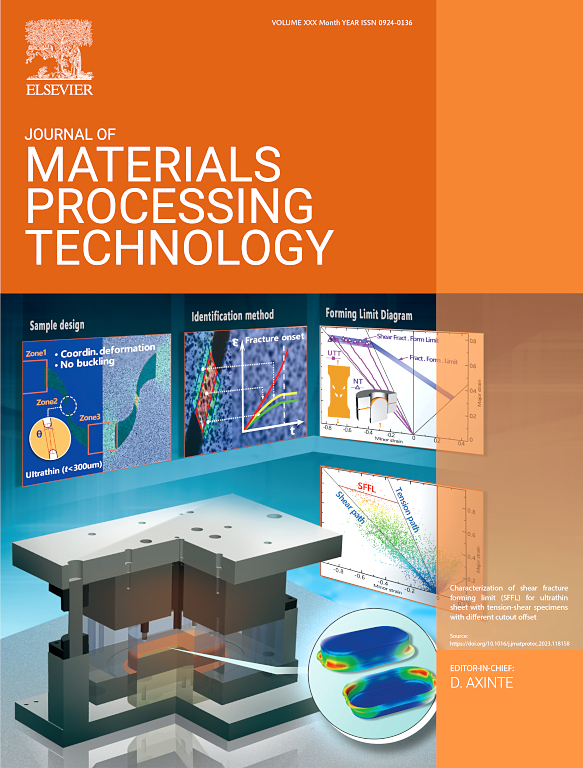定向能沉积加工中温度相关的显微组织演变和表面完整性- 316l
IF 7.5
2区 材料科学
Q1 ENGINEERING, INDUSTRIAL
Journal of Materials Processing Technology
Pub Date : 2025-08-25
DOI:10.1016/j.jmatprotec.2025.119044
引用次数: 0
摘要
在增减混合制造(ASHM)工艺中,增减阶段产生的余热存在于减减阶段,只能采用干切削。这导致加工零件的表面质量相对较差。因此,如何利用这些余热来提高表面质量是至关重要的。然而,这方面的研究仍然不清楚,也不够彻底。为了解决这个问题,使用定向能沉积(DED)制造的316 L不锈钢试样来研究铣削过程中工件温度升高对表面质量和刀具磨损的影响。系统地分析了材料的表面蓄能和微观结构的强化机制,揭示了结果的潜在机制。实验结果表明,工件温度(20 ~ 400℃)与加工效果之间存在非单调关系:随着温度从20℃升高到220℃,刀具磨损率降低,表面缺陷减少;然而,在260-400°C的温度范围内,这一趋势相反。这种转变与变形机制的根本变化有关:在高温下,材料中储存的能量减少,导致位错密度和孪晶界分数降低。这削弱了显微组织强化效果,降低了表面硬度,使材料更容易产生加工缺陷。当温度从20℃升高到220℃时,位错湮灭和晶界迁移加剧,导致晶粒细化层变薄。然而,随着温度继续升高到400℃,加速了新晶粒的形核,扩大了形核区,控制了变形机制,导致晶粒重熔层变厚。作为第一个将工件温升与加工工件中存储能量联系起来的研究,本工作为增减混合制造中优化工艺间温度管理建立了理论框架。这些发现促进了对ASHM的基本理解,同时为在实际减法加工过程中通过策略温度选择来提高表面完整性和刀具寿命提供了理论指导。本文章由计算机程序翻译,如有差异,请以英文原文为准。
Temperature-dependent microstructural evolution and surface integrity in machining of directed energy deposition-316L
In the additive-subtractive hybrid manufacturing (ASHM) process, residual heat from the additive stage exists during the subtractive stage, and only dry cutting can be used. This results in relatively poor surface quality of the machined parts. Therefore, how to make use of this residual heat to enhance the surface quality is of vital importance. However, research in this area remains unclear and insufficiently thorough. To address this issue, 316 L stainless steel specimens manufactured by directed energy deposition (DED) are used to investigate the effects of elevated workpiece temperature on surface quality and tool wear during the milling process. The surface energy storage, and the strengthening mechanisms of the material's microstructure are systematically analyzed to reveal the underlying mechanism of the results. Experimental results demonstrate a non-monotonic relationship between workpiece temperature (20—400 °C) and machining outcomes: As the temperature rises from 20 °C to 220 °C, the tool wear rate decreases and surface defects are reduced; however, this trend reverses in the temperature range of 260—400 °C. This transition is related to fundamental changes in deformation mechanisms: at elevated temperatures, the stored energy in the material decreases, resulting in reduced dislocation density and twin boundary fraction. This weakens the microstructural strengthening effect, lowers the surface hardness, and makes the material more prone to machining defects. When the temperature rises from 20 °C to 220 °C, the annihilation of dislocations and the migration of grain boundaries intensify, resulting in a thinner grain refinement layer. However, as the temperature continues to rise to 400 ℃, it accelerates the nucleation of new grains and expands the nucleation zone, controlling the deformation mechanism and resulting in a thicker grain remelting layer. As the first investigation linking workpiece temperature rise to stored energy in the machined workpiece, this work establishes a theoretical framework for optimizing inter-process temperature management in additive-subtractive hybrid manufacturing. The findings advance fundamental understanding of ASHM while providing theoretical guidelines for enhancing surface integrity and tool life through strategic temperature selection during practical subtractive processing.
求助全文
通过发布文献求助,成功后即可免费获取论文全文。
去求助
来源期刊

Journal of Materials Processing Technology
工程技术-材料科学:综合
CiteScore
12.60
自引率
4.80%
发文量
403
审稿时长
29 days
期刊介绍:
The Journal of Materials Processing Technology covers the processing techniques used in manufacturing components from metals and other materials. The journal aims to publish full research papers of original, significant and rigorous work and so to contribute to increased production efficiency and improved component performance.
Areas of interest to the journal include:
• Casting, forming and machining
• Additive processing and joining technologies
• The evolution of material properties under the specific conditions met in manufacturing processes
• Surface engineering when it relates specifically to a manufacturing process
• Design and behavior of equipment and tools.
 求助内容:
求助内容: 应助结果提醒方式:
应助结果提醒方式:


